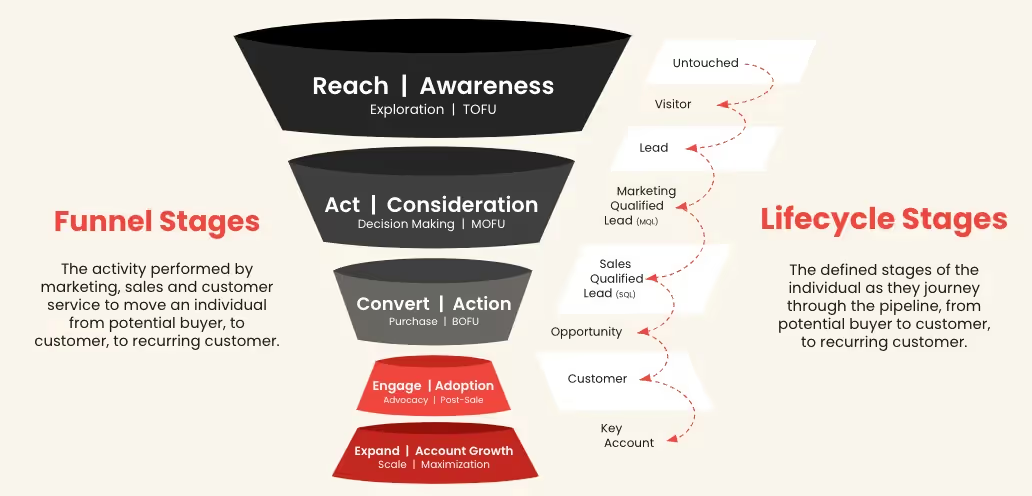


It's inevitable that some growth marketing strategies won't succeed. Failure could be due to poor planning, restrictive budgets, a lack of actionability, limited resources, or any number of the dozens of obvious reasons that are probably going through your head right now.
What's not always obvious are the elements that make a growth marketing strategy succeed. This article will describe six growth marketing best practices you'll see among successful strategies and actionable ways to incorporate them into your strategy.
You've likely heard Aristotle's saying "the whole is greater than the sum of its parts" before. It's especially true for growth marketing strategies.
Marketers working on unsuccessful strategies tend to focus on minor details like how an image looks. Meanwhile, those working on successful strategies look at the larger picture. Instead of pinning success on a single promotional tactic, they ensure each tactic contributes to the ultimate goal: converting leads into customers.
One great way to keep your focus on the whole sales funnel is to ask yourself, "how will this turn leads into customers?"

Another great trick to try is customer journey mapping — it helps you understand how potential customers will respond to each tactic so you can be deliberate about each point of contact.
Tip: Read "How To Build a PLG Funnel Your Sales Team Can Use" and "Speed To Lead: What Is It and How To Improve Yours."
An experienced growth marketing team knows that no two audience members have the same digital habits. Instead of focusing entirely on one channel, successful growth marketers take a multichannel approach to reach the widest audience possible.
As of 2022, the most popular channels for growth marketing are email marketing, Search Engine Optimization (SEO), content marketing, referral marketing, video marketing, social media marketing, and event-based marketing.
Thankfully, you don't need to come up with fresh content for each of these. You can re-purpose images, GIFs, copy, topics, and keywords. For instance, you could take sections of a blog post and turn them into a social media post or marketing email.
Tip: Use cross-promotion to direct traffic between channels during the lead nurturing process.
If you've read a lot of digital marketing content, you've likely seen the advice "make your campaign real-world data-driven" often. It's well-meaning (and effective), but non-data scientists often struggle to find actionable ways to use data.
That's where A/B testing (or "split testing") comes in.
With A/B testing, you publish two pieces of similar marketing with slight variations and compare their performance in the first few hours. Then, you use the winning variation to reach a wider audience.
For example, you could send out the same marketing email with different subject lines to see which line works better. Or you could A/B test:
The great thing about A/B testing is that it's fast, budget-conscious, and beginner-friendly. You can likely conduct A/B tests with tools you already have, including email marketing and social media analytics tools.
When you know who you are promoting to, you're better equipped to figure out what marketing messages, tactics, and approaches will work best with them. Successful growth marketers use buyer personas to pinpoint their target audience.
Buyer personas are fictional representations of audience members that identify characteristics like age, gender, location, income, education, occupation, values, desires, and goals.
The best way to get accurate buyer personas is to conduct market research on your customers. In particular, you want to concentrate on pain points, motivations, and their decision-making processes — these will help you understand what drives them.
Successful growth marketing strategies have clearly defined success criteria in the form of Key Performance Indicators (KPIs). KPIs give you a clear direction from the start and keep your strategy on track.
Here are some KPIs to try in your strategy:
An effective marketing strategy goes "all in" on the channels marketers choose to use.
In practice, for example, this means that if you're going to invest in a paid media campaign, you dedicate the staff, resources, capital, and effort to producing the best ad campaign possible.
At the same time, if you don't elect to use a tactic or channel, you just ignore it completely rather than put together a weak strategy. Invest all your resources into the channels you expect a strong return on.
Limited budgets, poor planning, sloppy execution, and a lack of foresight are common among ineffective growth marketing strategies. Meanwhile, successful marketing strategies share these six elements:
Mastering growth marketing can take your business far. With Matter Made's help, Productboard increased MoM ENT lead growth by 99%, and Dropbox increased Target Engagement 6.5 times.
Want help from growth marketing experts? Let's talk.